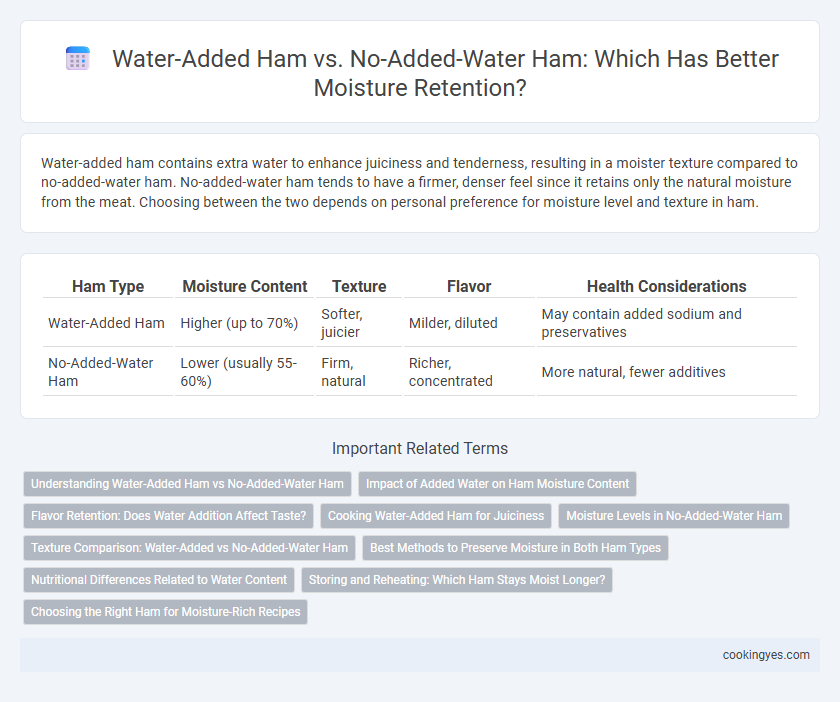Water-added ham contains extra water to enhance juiciness and tenderness, resulting in a moister texture compared to no-added-water ham. No-added-water ham tends to have a firmer, denser feel since it retains only the natural moisture from the meat. Choosing between the two depends on personal preference for moisture level and texture in ham.
Table of Comparison
| Ham Type | Moisture Content | Texture | Flavor | Health Considerations |
|---|---|---|---|---|
| Water-Added Ham | Higher (up to 70%) | Softer, juicier | Milder, diluted | May contain added sodium and preservatives |
| No-Added-Water Ham | Lower (usually 55-60%) | Firm, natural | Richer, concentrated | More natural, fewer additives |
Understanding Water-Added Ham vs No-Added-Water Ham
Water-added ham contains additional moisture injected during processing, increasing juiciness but potentially diluting natural flavor and altering texture. No-added-water ham relies solely on the water naturally present in the meat, maintaining a denser texture and stronger, more concentrated pork taste. Understanding these differences helps consumers choose based on preference for moisture content and flavor intensity.
Impact of Added Water on Ham Moisture Content
Water-added ham contains added water to increase moisture content, resulting in a juicier texture and enhanced weight. No-added-water ham relies solely on the meat's natural moisture, typically offering a firmer texture and more concentrated flavor. The presence of added water significantly influences the ham's overall moisture level, affecting both taste and mouthfeel.
Flavor Retention: Does Water Addition Affect Taste?
Water-added ham typically contains higher moisture levels, which can lead to a juicier texture but may dilute natural flavors. No-added-water ham preserves the meat's intrinsic taste, offering a more concentrated and robust flavor profile due to the absence of added water. Studies show that flavor retention is stronger in no-added-water ham, making it preferable for consumers seeking authentic ham taste.
Cooking Water-Added Ham for Juiciness
Cooking water-added ham enhances juiciness by incorporating added moisture during processing, which helps retain water content during heating, resulting in a tender and succulent texture. No-added-water ham typically has a denser texture with less retained moisture, often requiring careful cooking to prevent dryness. Proper cooking techniques, such as low-temperature baking or slow roasting, maximize the juiciness benefits of water-added ham by minimizing moisture loss.
Moisture Levels in No-Added-Water Ham
No-added-water ham contains higher intrinsic moisture levels naturally retained within the meat fibers, resulting in a more concentrated flavor and firmer texture compared to water-added ham. Moisture levels typically range between 50-60% in no-added-water ham, enhancing its juiciness without dilution from injected water or brine. This category is preferred for consumers seeking a purer, less processed product with authentic meat taste and improved mouthfeel.
Texture Comparison: Water-Added vs No-Added-Water Ham
Water-added ham contains added moisture that increases juiciness but can create a softer, sometimes spongier texture compared to no-added-water ham. No-added-water ham maintains natural meat density and firmness, resulting in a chewier, more robust bite. Texture differences significantly affect mouthfeel preference, with water-added ham favored for tenderness and no-added-water ham prized for a more authentic, meat-forward experience.
Best Methods to Preserve Moisture in Both Ham Types
Water-added ham improves moisture retention through injecting brine solutions that enhance juiciness and tenderness, while no-added-water ham relies on natural meat moisture and precise curing techniques to prevent dryness. Optimal preservation methods include vacuum sealing and controlled refrigeration for both types, minimizing moisture loss and microbial growth. Using enzymatic tenderizers and maintaining consistent storage humidity levels further ensures both water-added and no-added-water hams maintain maximum succulence.
Nutritional Differences Related to Water Content
Water-added ham contains higher moisture levels, which dilute its protein concentration and reduce calorie density compared to no-added-water ham. No-added-water ham maintains a denser nutrient profile with greater protein content and essential minerals per serving. Consumers seeking higher nutritional value and less sodium often prefer no-added-water ham due to its concentrated nutrient composition.
Storing and Reheating: Which Ham Stays Moist Longer?
No-added-water ham retains moisture longer during storage and reheating due to its lower water content and higher protein concentration, resulting in less water loss and improved texture. Water-added ham, containing injected water, tends to lose more moisture and becomes drier when reheated or stored over time. Proper refrigeration and gentle reheating methods further help maintain the juiciness of no-added-water ham compared to water-added varieties.
Choosing the Right Ham for Moisture-Rich Recipes
Water-added ham contains injected water or brine, increasing overall moisture content and enhancing juiciness ideal for moisture-rich recipes like casseroles or sandwiches. No-added-water ham retains its natural moisture, offering a firmer texture and concentrated flavor, preferred in dishes where ham's taste stands out. Selecting between these depends on desired moisture level and flavor intensity in your culinary preparation.
Water-added ham vs no-added-water ham for moisture Infographic

 cookingyes.com
cookingyes.com